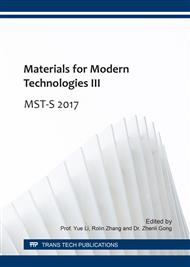p.155
p.162
p.167
p.175
p.182
p.193
p.198
p.202
p.209
Numerical Study on the Impact of Second Phase Content on the Solidification of Al-Pb Hypermonotectic Alloys
Abstract:
Based on the Euler-Euler method and the conservation equation, a mathematical model for describing the non-steady processes of mass transfer, transmission, heat transfer, solute transport and nonstationary process of nucleation in liquid-liquid separation of Al-Pb monotectic alloys was established. The influence of the second phase content on the solidification microstructure of Al-Pb alloy was analyzed by numerical simulation by combining the calculated temperature field and velocity field with the kinetic equation of controlling solidification microstructure evolution. The results show that the lower the second phase content is, the more uniform the temperature field distribution is, and the lower the velocity of the second phase droplets is. The average diameter and volume fraction of the second phase droplets in the Al-5wt%Pb alloy samples were lower than that in the Al-10wt%Pb alloy samples under the same conditions. It is concluded that the lower the content of the second phase, the liquid - liquid phase separation and decomposition behavior of liquid immiscible liquid in the immiscible zone are relatively slow, and the more easily the droplets of the second phase are distributed uniformly in alloy solidification structure of the matrix.
Info:
Periodical:
Pages:
209-215
Citation:
Online since:
March 2017
Authors:
Price:
Сopyright:
© 2017 Trans Tech Publications Ltd. All Rights Reserved
Share:
Citation:


